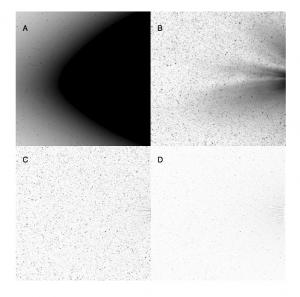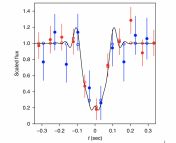TITLE: A Search for Vulcanoids with the STEREO Heliospheric Imager
AUTHORS: A. J. Steffl, N. J. Cunningham, A. B. Shinn, D. D. Durda, S. A. Stern
FIRST AUTHOR’S INSTITUTION: Southwest Research Institute, Boulder

STEREO images being processed for Vulcanoid searches. In panel a), the original image. Panel b), image after removal of the solar corona. Panel c), image after removal of solar streamers and flares. Panel d), subtracted images to delete fixed sources (i.e. stars). Only small moving sources (and noise) should remain.
The recent evidence for an asteroid belt in the Vega system highlights how well we’re getting to know the solar systems around other stars. But there are some surprising gaps in our knowledge of our own. Inwards of the orbit of Mercury, there exists a dynamically stable region between about 0.21 AU and 0.07 AU where objects can orbit without being perturbed by Mercury or vaporized by the Sun. As far back as 1859 astronomers proposed that there might be at least one small planet lurking in this region, at the time a potential explanation for the odd precession of Mercury, and gave this hypothetical world the name “Vulcan”. Although Mercury’s orbital behavior was later explained by Einstein using general relativity, the idea of close-in planetesimals called “Vulcanoids” stuck around. The orbital motions of Mercury, Venus, and the Sun rule out a planet, but there’s still room for smaller objects. We now know that many, many exoplanet systems feature full-blown planets that orbit far closer in to their stars than Mercury does to the Sun. Why not some debris in ours?
But how could something comparatively right next door go undetected for so long? Their very closeness to the Sun makes them hard to see. From Earth’s perspective, objects in the Vulcanoid region never stray farther than about 12 degrees from the Sun in the sky. From the ground they can only be observed in the early twilight, and even then they are almost certain to be lost in the Sun’s glare. As late as the 1980s the only major searches for Vulcanoids had been conducted in the short minutes of totality during total solar eclipses. Later searches were conducted with the coronagraphs aboard solar observing satellites like SOHO and the cameras onboard the MESSENGER spacecraft headed to Mercury. They failed to detect any Vulcanoids and put constraints on their possible sizes, limiting most of the asteroids to below 50 km and in some cases below 15 km.

Orbits of the synthetic Vulcanoids injected into the data. Only objects with diameters around 5 km or higher were recovered by the observers, suggesting an upper limit on the possible size of any remaining real Vulcanoids.
The authors conduct an archive search using the data from the Heliospheric Imager onboard the STEREO solar observing spacecraft; STEREO consists of two spacecraft in Earth-leading and Earth-trailing orbits that continually image the solar corona. If there are Vulcanoids, they should be visible in the background. They search images spanning a long enough time that any Vulcanoids orbiting within the region should have passed through the instrument’s field of view at least once, unless they were in highly eccentric or highly inclined orbits. After stripping out the coronal mass ejections and other solar phenomena that constitute STEREO’s main dataset, the authors compiled the images into little movies played at variable framerates and had human observers flag possible motion, taking advantage of the edge the human eye has over computers at detecting moving objects. They also created a population of 101 synthetic Vulcanoid signals that were injected into the data to ensure that observers were able to see the real Vulcanoids if they were there.
Although the searchers flagged 4 planets, dozens of sungrazing comets, many main-belt asteroids, and 58 of the 101 synthetic signals, they found no real Vulcanoids. Based on the observer efficiency the authors are therefore able to place an upper limit of 5.7 km on the size of any Vulcanoid. From simulations it seems that even if there were a primordial Vulcanoid population, orbital resonances and collisions would have likely reduced it to debris that would have been in turn swallowed by the Sun by now. So our solar system may, in the end, be a little bit cleaner than we thought.





Any unending quest eventually leads to Esperanto.